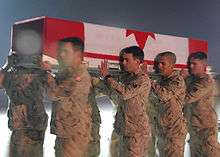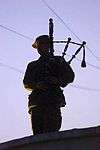Canadian Forces casualties in Afghanistan

The number of Canadian Forces' fatalities resulting from Canadian military activities in Afghanistan is the largest for any single Canadian military mission since the Korean War between 1950 and 1953. A total of 159 Canadian Forces personnel have been killed in the war since 2002.[1]
Specifics
The first casualties occurred in the Tarnak Farm incident, in which four Canadians were killed and eight seriously wounded when a United States warplane dropped a bomb on a training exercise in the belief that the Canadians were enemy soldiers. The four servicemen were honoured at an event unprecedented in Canada 2002, Skyreach Centre in Edmonton, Alberta, was filled to capacity for a tribute ceremony for the four deceased soldiers that included personal messages from the Governor General Adrienne Clarkson, Prime Minister Jean Chretien, the Chief of Defence Staff, Premier of Alberta and Premier of Manitoba, and the Mayor of Edmonton, Alberta, most of whom also attended the service. Subsequently, deceased soldiers have been honoured by much smaller services. On 9 April 2007, Elizabeth II made reference to all the deceased Canadians in Afghanistan when she rededicated the Vimy Memorial "to their eternal remembrance, to Canada, to all who would serve the cause of freedom, and to those who have lost their lives in Afghanistan."[2] Further, in honour of all those who died during the Afghan mission, the section of Ontario's Highway 401 along which deceased soldiers are carried from Canadian Forces Base Trenton to Toronto after repatriation was named the Highway of Heroes.[3] All those Canadian Forces personnel who are killed during the mission are posthumously awarded the Sacrifice Medal and their spouse or next of kin receive the Memorial Cross.
The first deployed Canadian woman combatant to die in combat was Captain Nichola Goddard, and the death of Anthony Boneca initiated debate around the combat readiness of Canadian reservists, wherein questions were asked not only about the suitability of employing reservists, but also the role of the media in reporting comments by grief-stricken relatives, such as those made by Boneca's partner's father. The suitability of the Iltis vehicle was also questioned heavily following a land mine incident on 2 Oct 03 that claimed the lives of two Canadian soldiers, Cpl Robbie Beerenfenger and Sgt Robert Short, leading the military to thereafter acquire Mercedes-Benz G-Class and RG-31 Nyala armoured patrol vehicles.[4]
The first Canadian woman to commit suicide on an overseas deployment was Major Michelle Mendes, an intelligence officer, who died from self-inflicted gunshot wounds at Kandahar Airfield on 24 Apr 09 only a few days after her arrival.[5]
The first gravely injured Canadian soldier to redeploy in Kandahar was Captain Simon Mailloux in November 2009. Capt Mailloux had been gravely injured in November 2007 following an IED incident in the Panjwayi district and his left leg had to be amputated. Two more Canadian soldiers, Corporal Nicholas Beauchamp and Private Michel Levesque, died in the same incident.

The highest ranking casualty was sustained on 18 May 2010, when Colonel Geoff Parker was killed after a suicide bomber drove a car full of explosives into a NATO convoy during a morning rush hour on the edge of Kabul. 5 U.S. soldiers and 12 Afghan civilians were also killed in this attack.[6]
On November 28, 2014, Veterans Affairs Canada attributed Cpl Jacques Larocque's (8 AMS Trenton) death (August 27, 2005) to the Afghanistan mission. On September 21, 2015 the city of Quinte West confirmed they were to add another name to the monument, Cpl Jacques Larocque's name was added on October 16, 2015 as the 159th Canadian soldier who died in active service on the Afghan mission.
Statistics
Fatalities by rank
| Rank | Number |
|---|---|
| General Officers (officiers généraux) | |
| TOTAL | 0 |
| Senior Officers (officiers supérieurs) | |
| Colonels | 1 |
| Majors | 3 |
| TOTAL | 4 |
| Junior Officers (officiers subalternes) | |
| Captains | 6 |
| Lieutenants | 3 |
| TOTAL | 9 |
| NCM Senior Rank (Rangs supérieurs) | |
| Chief Warrant Officer | 1 |
| Master Warrant Officer | 1 |
| Warrant Officers | 6 |
| Sergeants (17 Sergeants, 1 Petty Officer 2nd Class) | 18 |
| TOTAL | 26 |
| NCM Junior Ranks (Rangs subalternes) | |
| Master Corporals | 16 |
| Corporals (55 Corporals, 3 Bombardiers) | 58 |
| Privates (30 Privates, 10 Troopers, 1 Gunner, 5 Sappers) | 46 |
| TOTAL | 120 |
| TOTAL | ∞ |
Fatalities by cause
| Cause | Number |
|---|---|
| Enemy action | |
| Explosives | 97 |
| Direct fire | 22 |
| Suicide attacks | 13 |
| TOTAL | 132 |
| Non-enemy action | |
| Friendly-fire | 6 |
| Vehicle accidents | 6 |
| Helicopter accidents | 2 |
| Accidental falls | 2 |
| Accidental gunshots | 2 |
| Suicides | 3 |
| Unspecified | 4 |
| Illness | 2 |
| TOTAL | 27 |
| TOTAL | 159 |
Notable fatalities
On 17 May 2006, 26-year-old Captain from the 1 Royal Canadian Horse Artillery was killed during operations against insurgents. She was the first Canadian female soldier to die in combat.[7] On 4 September the same year, Olympic athlete Private Mark Anthony Graham from the 1st Battalion The Royal Canadian Regiment was killed by a US A-10 Warthog attack aircraft in a friendly fire incident. Dozens of other Canadians were wounded in the incident.[8][9]
Non-fatal casualties
Figures released by DND in January 2011 show that the total number of Canadian soldiers injured and wounded in more than nine years of war reached 1,859 by the end of December 2010.[10] 1,244 of these are listed as NBI (Non battle injuries) and 615 are listed as WIA (wounded in action).
Following a policy change at the beginning of 2010, the Canadian military began to withhold all injury reports, releasing only statistics after the end of a calendar year, citing security reasons.[11]
The Department of National Defence also refuses to disclose the nature or severity of injuries and wounds, as it is an operational secret.[12]
See also
- Canada's role in the invasion of Afghanistan
- Coalition casualties in Afghanistan
- Criticism of the War on Terror
- Opposition to the War in Afghanistan (2001–present)
- International public opinion on the war in Afghanistan
- Protests against the War in Afghanistan (2001–present)
References
- ↑ "Operation Enduring Freedom | Afghanistan". iCasualties. 31 March 2010. Retrieved 4 April 2010.
- ↑ "Latest News and Diary > Speeches and articles > 2007 > 90th anniversary of the Battle of Vimy Ridge, 9 April 2007". Buckingham Palace. 9 April 2007. Retrieved 9 April 2009.
- ↑ "Section of the 401 to be renamed to The Highway of Heroes". CTV. 24 August 2007. Archived from the original on 9 May 2009. Retrieved 9 April 2009.
- ↑ Canadian Press (13 August 2006). "Defence Minister, military at odds over G-wagons". The Globe and Mail. Archived from the original on 18 August 2006. Retrieved 9 April 2009.
- ↑ Brewster, Murray (10 August 2010), Forces closes book on officer's suicide, but troubling questions persist, The Canadian Press, retrieved 31 October 2011
- ↑ "Canadian colonel among six soldiers killed in Kabul suicide attack, 18 May 2010". Globe and Mail. Canada. 18 May 2010. Retrieved 18 May 2010.
- ↑ "CBC News > Indepth: Afghanistan > May 17, 2006: Female soldier killed". CBC. 17 May 2006. Retrieved 9 April 2009.
- ↑ Canadian Press (10 November 2008). "Canada's Afghan war dead". Canoe. Retrieved 9 April 2009.
- ↑ "Canadian killed by friendly fire in Afghanistan". CTV. 5 September 2006. Archived from the original on 14 June 2009. Retrieved 9 April 2009.
- ↑ "Canadian Forces' Casualty Statistics (Afghanistan)". Canada News Center. 12 January 2011. Retrieved 14 February 2011.
- ↑ Potter, Mitch (4 May 2010). "Another Canadian soldier killed by roadside bomb in Afghanistan". Toronto Star. Toronto. Retrieved 20 February 2011.
- ↑ The Canadian Press (19 December 2010). "Cpl. Steve Martin 154th soldier to die as a result of Afghanistan war". Toronto Star. Toronto. Retrieved 20 February 2011.
External links
- Ottawa Citizen searchable database of Canadian casualties in Afghanistan
- CBC News Indepth: Afghanistan, Canadian casualties
- DND site for Afghanistan casualties
- The Canadian Virtual War Memorial (allows search for information about the dead by name)
- CTV.ca News article listing casualties
- icasualties.org list of Canadian casualties in Afghanistan
- CASR: Hard Numbers – CF Afghanistan Casualties by Vehicle Type, listed Chronologically (up to 18 Feb 2008)
- Cpl Jacques Larocque name officially announced as number 159 to Afghan Memorial
